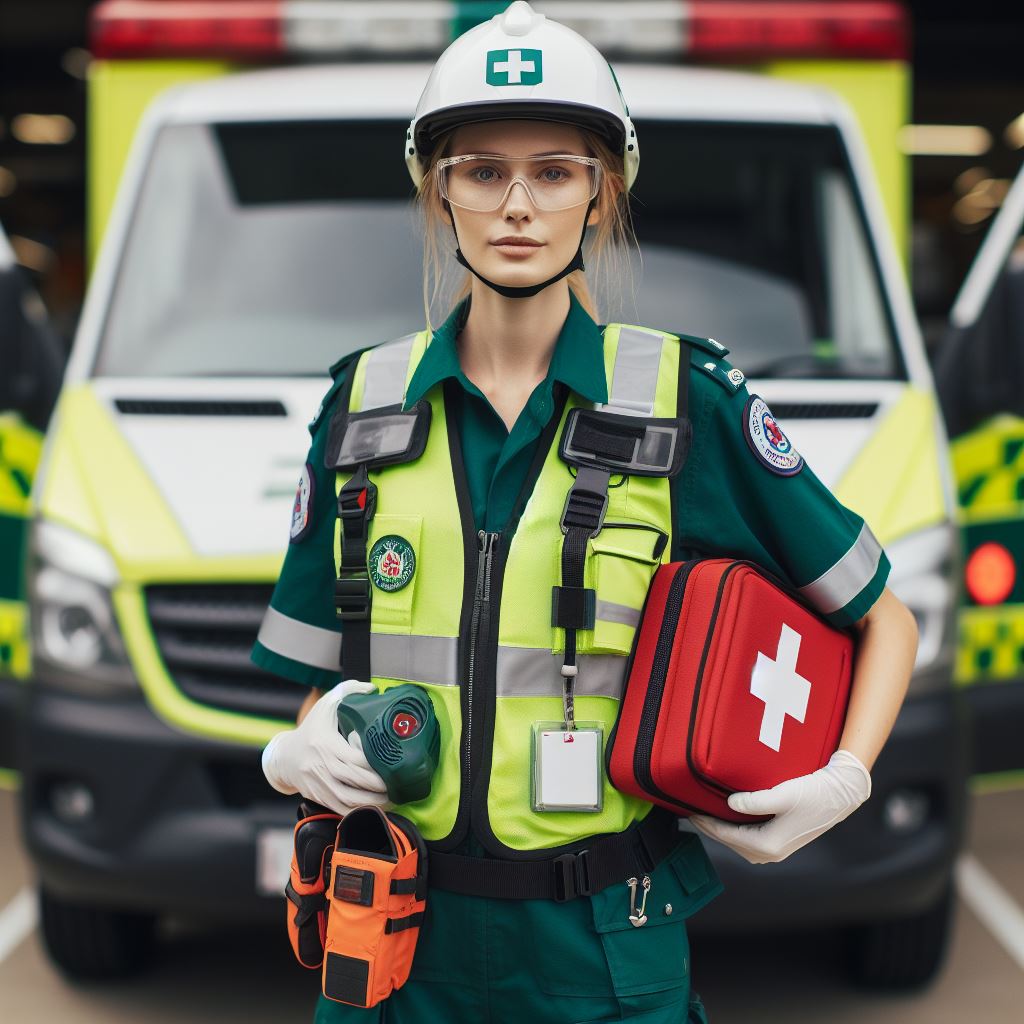Introduction
In the dynamic realm of paramedicine, technology is reshaping the way emergency medical services are delivered.
This blog, focusing on an Australian perspective, delves into the integration of cutting-edge technologies in the country’s paramedic practices.
Unraveling the impact of technology on response times, patient care, and overall efficiency in the Australian emergency medical landscape, from innovative diagnostic tools to advanced communication systems.
Join us as we explore the exciting advancements and the challenges posed by the adoption of technology in paramedicine.
This examination highlights strides in healthcare delivery improvement, showcasing Australia’s paramedics’ ongoing commitment to embracing innovations for swift, effective, and technologically-informed care.
Overview of paramedicine in Australia
A brief overview of the paramedicine field in Australia
In Australia, the field of paramedicine plays a critical role in the healthcare system. Paramedics are skilled professionals who provide emergency medical care and transport patients to appropriate medical facilities.
Paramedicine in Australia is regulated by the Australian Health Practitioner Regulation Agency (AHPRA) and the Paramedicine Board of Australia.
To become a paramedic, individuals must complete a Bachelor’s degree in paramedicine and gain registration with these regulatory bodies.
Paramedics in Australia are trained to respond to a wide range of emergency situations, including accidents, medical emergencies, and trauma incidents.
They are equipped with the necessary skills and knowledge to assess, treat, and stabilize patients in pre-hospital settings.
Paramedics often work in collaboration with other healthcare professionals, such as doctors, nurses, and emergency department staff.
The important role of paramedics in the healthcare system
They are an integral part of the healthcare team and their role extends beyond responding to emergencies. Paramedics also play a vital role in preventive healthcare and public health education.
Paramedic services in Australia are provided by various organizations, including state-run ambulance services, private ambulance services, and volunteer organizations.
These organizations work together to ensure a prompt and efficient response to emergencies across the country.
Paramedics in Australia are equipped with advanced medical equipment and technology to assist in their emergency response.
They have access to defibrillators, cardiac monitors, intravenous medications, and other life-saving tools.
Paramedicine in Australia is constantly evolving with advancements in technology.
Telehealth and telemedicine are emerging trends in paramedicine, allowing paramedics to consult with doctors remotely and access real-time medical advice.
Paramedics also utilize mobile applications and electronic patient care records to enhance communication, documentation, and patient care.
These technological advancements improve efficiency and accuracy in the field of paramedicine.
In addition to emergency care, paramedics in Australia are involved in community outreach programs and community engagement.
They conduct first aid training, health promotion campaigns, and provide public health education to ensure the well-being of the community.
Overall, paramedicine in Australia plays a crucial role in the healthcare system, providing essential emergency medical care and support.
Paramedics are highly skilled professionals who are dedicated to saving lives and improving the health outcomes of the Australian population.
Read: Australian Health System: Doctors’ Perspective
Traditional methods in paramedicine
Traditional methods used by paramedics in Australia
Paramedics in Australia traditionally use various methods to provide emergency care, including basic life support techniques like CPR and first aid.
They rely on knowledge and experience to make quick decisions in critical situations.
Your Personalized Career Strategy
Unlock your potential with tailored career consulting. Get clear, actionable steps designed for your success. Start now!
Get StartedThe challenges faced by paramedics in providing timely and efficient care
Challenges include difficulties in providing timely and efficient care due to traffic congestion and difficult terrains, especially in rural and remote areas.
Limited availability of resources and equipment in some regions is an additional challenge.
Paramedics often have to work with what they have, making the best use of their skills and improvising when needed.
The reliance on paper-based documentation and manual processes
Traditional paramedicine in Australia relies on paper-based documentation, with manual recording of patient information, treatment provided, and medical history.
Paper-based documentation can be time-consuming, prone to errors or missing information, and not easily accessible or transferable between healthcare providers.
Despite challenges, paramedics in Australia have been providing essential pre-hospital care for decades, saving countless lives and making a significant difference in emergency situations.
There is a growing recognition of the need to embrace technology in paramedicine to overcome existing challenges.
Technology incorporation includes the use of GPS navigation systems to reach the scene faster and avoid traffic.
Electronic patient care records improve the accuracy and accessibility of patient information, facilitating better decision-making.
Technology aids in communication between paramedics and other healthcare providers, with real-time transmission of patient data for seamless handover and continuity of care.
Implementing technology enhances paramedics’ ability to provide timely and efficient care, improving patient outcomes by reducing delays and ensuring accurate information flow.
Essentially, traditional methods in paramedicine have served Australia well, but they come with limitations. The reliance on paper-based documentation and manual processes can hinder timely and efficient care.
However, with advancements in technology, paramedics can overcome these challenges and improve patient care outcomes.
Read: The Role of Technology in Australian Healthcare
The Integration of Technology in Paramedicine: An Aussie Outlook
Advancements in Technology in Australian Paramedicine
- In recent years, there have been significant advancements in technology within the field of paramedicine in Australia.
- One notable advancement is the implementation of electronic patient care records (ePCR) systems.
- These ePCR systems allow paramedics to document patient information electronically, improving accuracy and efficiency.
- Another important technological advancement is the use of telehealth solutions in paramedicine.
- Telehealth enables paramedics to connect with healthcare professionals remotely to seek guidance and support.
- Additionally, Australia has seen the integration of GPS technology into ambulance vehicles.
- This allows for real-time tracking of ambulances, helping to improve response times and overall efficiency.
- Moreover, the use of wearable technology, such as smartwatches, has become increasingly prevalent in the paramedicine field.
- Paramedics can use these devices to monitor vital signs and receive important notifications while on duty.
- Furthermore, there has been a growing focus on implementing data analytics in paramedicine.
- Data analytics can help identify trends and patterns in patient care, leading to improved decision-making and better outcomes.
Adoption of Mobile Technologies by Paramedics
- Paramedics in Australia have embraced the use of mobile technologies, specifically tablets and smartphones.
- These devices provide paramedics with easy access to medical references, protocols, and clinical guidelines.
- Tablets and smartphones also allow paramedics to communicate with healthcare professionals, both in real-time and for consultation purposes.
- Mobile technologies have streamlined the process of obtaining medical advice and seeking second opinions.
- Paramedics can quickly access information and discuss patient cases with specialists, enhancing patient care.
- The adoption of mobile technologies has also facilitated the sharing of information among paramedics.
- Through secure messaging applications and digital platforms, paramedics can exchange knowledge, experiences, and best practices.
Improvements in Communication, Access to Information, and Patient Care
- The integration of technology in paramedicine has greatly improved communication between paramedics and healthcare professionals.
- Paramedics can transmit patient information, including vital signs and images, instantly to hospitals, enabling better preparedness.
- Access to information has significantly improved with the integration of technology.
- Paramedics can quickly access medical databases, drug databases, and medical literature through their mobile devices.
- This immediate access to information enhances diagnostic accuracy and supports evidence-based decision-making.
- Technology has also enhanced patient care by enabling paramedics to provide real-time updates to hospitals during transit.
- With the use of mobile devices, paramedics can transmit ECGs or other relevant data to the hospital, expediting treatment planning.
- The integration of technology has also led to improved accuracy and efficiency in documentation and record-keeping.
- Paramedics can digitally capture patient information and sync it with the electronic health record system, reducing errors and duplication.
Ultimately, the integration of technology in paramedicine has brought about significant advancements in Australia.
From electronic patient care records to mobile technologies, these advancements have greatly improved communication, access to information, and overall patient care.
Paramedics in Australia have embraced these technologies, recognizing the benefits they bring to their practice.
The future of technology in paramedicine looks promising, with further advancements on the horizon to enhance the field and ultimately improve patient outcomes.
Stand Out with a Resume That Gets Results
Your career is worth more than a generic template. Let us craft a resume and cover letter that showcase your unique strengths and help you secure that dream job.
Get HiredRead: Rural Medicine in Australia: A Closer Look

The benefits of technology in paramedicine
In the field of paramedicine, technology has revolutionized the way emergency medical services (EMS) operate and deliver care.
Through the integration of cutting-edge tools and systems, paramedics can now provide faster, more efficient, and precise care to patients in need.
This section discusses the numerous benefits that technology brings to the paramedicine field.
Improved response times
One significant advantage of technology in paramedicine is the improvement in response times.
With the aid of GPS systems and real-time traffic data, paramedics can navigate through the fastest routes, bypassing heavy traffic and reaching emergencies more quickly.
This reduction in response times can greatly impact patient outcomes, as prompt medical intervention is crucial in critical situations.
Enhanced decision-making abilities
Additionally, technology enhances paramedics’ decision-making abilities, leading to more accurate diagnoses and treatment plans.
Advanced medical equipment, such as portable ultrasound machines and ECG monitors, enables paramedics to gather crucial medical information on the scene.
These tools, coupled with computerized systems that provide access to medical databases and treatment protocols, empower paramedics to make informed decisions quickly.
Better patient outcomes
The use of technology also allows for better patient outcomes. With advanced equipment and improved diagnostic capabilities, paramedics can start appropriate interventions promptly.
This can significantly increase a patient’s chance of survival and recovery.
Efficient communication
Furthermore, technology facilitates real-time communication between paramedics and hospitals.
This enables seamless handovers and ensuring patients receive the right care from the moment they enter the ambulance to their arrival at the emergency department.
Modern communication tools such as radios, mobile phones, and GPS systems facilitate seamless coordination between paramedics and other emergency response units.
Remote diagnostics
Telemedicine capabilities empower paramedics to consult with medical professionals in real-time, improving the accuracy of diagnoses and treatment plans.
Streamlined documentation
Digital systems for recording patient data and medical history ensure accurate and easily accessible records for future reference and research.
Training and education
Cutting-edge simulators and virtual reality technology allow paramedics to practice and enhance their skills without putting real patients at risk.
Remote monitoring
Wearable devices and wireless sensors enable paramedics to remotely monitor patients’ vital signs and intervene promptly when necessary.
Data tracking and analysis
Another benefit is the ability to track and analyze data for continuous improvement within the paramedicine field.
Through digital systems, paramedics can collect and analyze data on response times, treatment outcomes, and public health trends.
This information can be used to identify areas for improvement, implement effective training programs, and allocate resources more efficiently.
Data-driven decision-making leads to better patient care and overall system effectiveness.
Efficient resource allocation
Integrated dispatch systems help optimize the allocation of resources, ensuring that the nearest available paramedics are sent to emergencies.
In conclusion, technology offers numerous benefits to the paramedicine field.
The integration of technology has transformed the way paramedics provide care, enhancing response times, decision-making, patient outcomes, and continuous improvement through data analysis.
As technology continues to advance, the future of paramedicine looks promising, with even greater possibilities for improved emergency medical services.
Transform Your LinkedIn for Maximum Impact
Elevate your professional brand with a LinkedIn profile that attracts recruiters, showcases your expertise, and maximizes opportunities. Stand out in your industry with a profile built for success.
Boost ProfileRead: Work-Life Balance for Aussie Doctors
Challenges and Limitations in Technology Integration in Paramedicine
Maintaining Patient Privacy and Data Security
- Ensuring patient privacy is a crucial challenge in technology integration in paramedicine.
- With the use of electronic health records and telemedicine, protecting sensitive patient data becomes critical.
- Paramedics need to be trained in data security measures and adhere to strict protocols to prevent unauthorized access.
- Data breaches can lead to significant consequences, such as identity theft or compromised patient care.
Ongoing Training and Education for Paramedics
- Technological advancements create a need for continuous training and education among paramedics.
- Paramedics must be equipped with the skills to effectively use new medical devices and software.
- Regular training sessions and workshops are necessary to keep paramedics updated with the latest technology.
- Continuous education ensures paramedics can adapt quickly to new tools, improving patient care and outcomes.
Technological Limitations in Paramedicine
- Despite the benefits of technology, there are limitations that paramedics need to address.
- Dependence on technology may lead to a lack of reliance on essential clinical skills.
- Technical glitches and system failures can occur, hampering access to vital information during emergencies.
- Paramedics should always be prepared for scenarios where technology fails and have manual alternatives in place.
Integration of Technology with Human Interaction
- Technology should supplement, not replace, human interaction in the paramedicine field.
- Maintaining a balance between technology and personalized patient care is crucial for successful integration.
- Over-reliance on technology may diminish the importance of empathetic communication and patient assessment skills.
- Paramedics must strive to blend technology and compassionate care, providing holistic medical assistance.
Regulatory and Legal Challenges
- The integration of technology in paramedicine poses regulatory and legal challenges.
- Confidentiality and legal compliance need to be carefully considered in the collection and sharing of patient data.
- Adhering to local, state, and federal regulations ensures the legal and ethical use of technology in patient care.
- Paramedics must understand and comply with the laws and regulations applicable to the use of medical technology.
Generally, the integration of technology in paramedicine offers numerous benefits but comes with challenges and limitations.
Maintaining patient privacy, ensuring data security, and addressing ongoing training needs are crucial. Technology should be seen as a tool to enhance, not replace, human interaction and compassionate care.
Paramedics need to adapt to technological advancements while understanding and complying with legal and regulatory requirements.
By overcoming these challenges, technology can play a pivotal role in improving the efficiency and effectiveness of paramedicine.
Uncover the Details: Navigating Public Health Regulations in Oz
Learn More: Latest Surgical Technologies Used in Perth
Future possibilities and emerging technologies
The potential future possibilities and emerging technologies in paramedicine
In recent years, the field of paramedicine has witnessed remarkable advancements, driven by emerging technologies and innovative approaches.
The future possibilities in this field are both exciting and promising, with potential implications for improving patient care and outcomes.
The use of artificial intelligence, virtual reality, and telemedicine
One significant area of development is the integration of artificial intelligence (AI) into paramedicine.
AI has the potential to revolutionize various aspects of patient care, such as diagnosis, treatment planning, and decision-making support.
With AI algorithms analyzing patient data more efficiently and accurately than ever before, paramedics can make better-informed decisions on the scene.
Such technologies can also help predict patient outcomes and provide personalized treatment plans.
Virtual reality (VR) is another emerging technology with potential applications in paramedicine. By immersing paramedics in realistic scenarios, VR can enhance training and simulation experiences.
Through VR, paramedics can practice critical skills repeatedly in a safe environment, boosting their proficiency and confidence.
Additionally, VR can offer valuable insights into patient experiences, enabling paramedics to empathize and understand better how patients feel during emergencies.
Telemedicine is a growing field that allows remote access to healthcare services, and its potential in paramedicine is immense.
In the vast Australian outback, where remote communities often struggle with limited access to medical care, telemedicine offers a lifeline.
Paramedics equipped with video conferencing capabilities can consult with specialized physicians, receiving real-time guidance to assist with complex cases.
This technology reduces the need to transport patients long distances for expert care, potentially saving lives through timely interventions.
Australian-specific initiatives or projects in this area
Australia, known for its innovative healthcare system, has witnessed several initiatives and projects aimed at harnessing technology in paramedicine.
For example, the Queensland Ambulance Service has introduced a telehealth program that enables paramedics to connect with remote health professionals for consultation and assistance.
This initiative ensures that patients in remote areas receive the best care possible, regardless of their geographical location.
Furthermore, the Royal Flying Doctor Service, Australia’s iconic aeromedical organization, has embraced technology to deliver advanced care in remote locations.
Their telehealth initiatives allow paramedics to connect with physicians via video conferencing, facilitating real-time collaboration and decision-making.
These projects have proven vital in saving lives and ensuring the provision of high-quality care in Australia’s vast rural areas.
In essence, the future possibilities and emerging technologies in paramedicine hold immense promise for transforming patient care.
Artificial intelligence, virtual reality, and telemedicine offer innovative approaches to improve patient outcomes and enhance the capabilities of paramedics.
In Australia, the implementation of these technologies in initiatives like telehealth programs and aeromedical services has shown significant benefits in providing equitable healthcare to remote communities.
As technology continues to advance, the potential for further improvements in paramedicine remains vast.
You Might Also Like: Surgeons and Healthcare Policies in Oz
Conclusion
Technology has proven to be a game-changer in the field of paramedicine. It has transformed the way paramedics operate, allowing for more efficient and effective patient care.
By utilizing new technologies such as telemedicine, mobile apps, and wearables, paramedics can provide real-time monitoring, faster communication, and accurate diagnosis.
The benefits of technology in paramedicine are immense. It has improved response times, reduced medical errors, and enhanced overall patient outcomes.
Moreover, it has the potential for future advancements, such as artificial intelligence integration and predictive analytics, which can revolutionize the paramedic profession.
To stay on top of the latest developments, it is crucial for paramedics and aspiring paramedics to stay updated on emerging technologies.
Regularly attending conferences, workshops, and subscribing to professional journals can help them stay informed and adapt to the ever-evolving landscape of technology in paramedicine.
By embracing technology and its advancements, paramedics can continue to improve the quality of care they provide to patients.
By staying informed and embracing innovation, they can ensure they are equipped with the latest tools and techniques to save lives and make a difference in the field of paramedicine.




